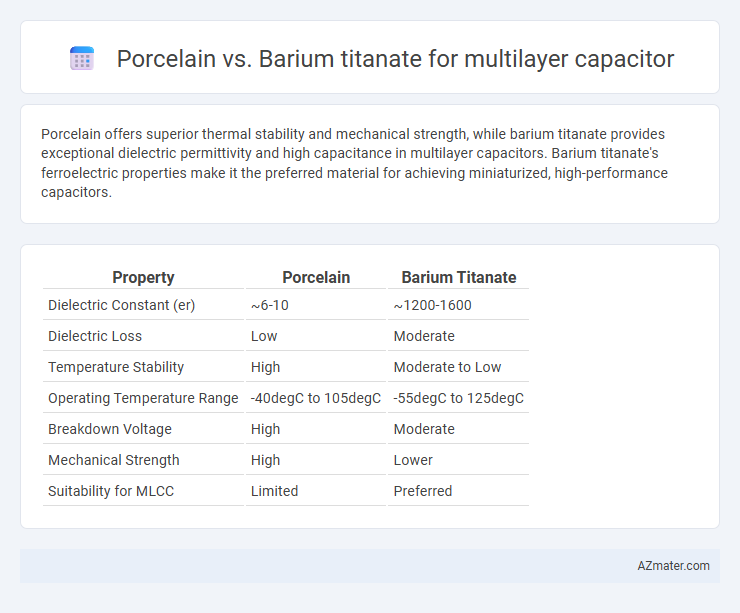Porcelain offers superior thermal stability and mechanical strength, while barium titanate provides exceptional dielectric permittivity and high capacitance in multilayer capacitors. Barium titanate's ferroelectric properties make it the preferred material for achieving miniaturized, high-performance capacitors.
Table of Comparison
| Property | Porcelain | Barium Titanate |
|---|---|---|
| Dielectric Constant (er) | ~6-10 | ~1200-1600 |
| Dielectric Loss | Low | Moderate |
| Temperature Stability | High | Moderate to Low |
| Operating Temperature Range | -40degC to 105degC | -55degC to 125degC |
| Breakdown Voltage | High | Moderate |
| Mechanical Strength | High | Lower |
| Suitability for MLCC | Limited | Preferred |
Introduction to Multilayer Capacitors
Multilayer capacitors (MLCCs) utilize ceramic materials such as porcelain and barium titanate to achieve high capacitance in compact sizes, with barium titanate offering superior dielectric constants for enhanced performance. Porcelain-based MLCCs provide stability and reliability in various temperature ranges, whereas barium titanate enables higher permittivity and improved energy storage capabilities. Selection between porcelain and barium titanate depends heavily on the desired electrical characteristics and operating environment of the capacitor.
Overview of Porcelain as Dielectric Material
Porcelain as a dielectric material in multilayer capacitors offers excellent mechanical strength, high temperature stability, and good insulating properties due to its ceramic composition primarily of kaolin and feldspar. Unlike barium titanate, porcelain exhibits lower dielectric constant values but provides superior reliability and resistance to thermal shock, making it suitable for high-frequency and high-voltage applications. Its crystalline structure and high resistivity contribute to stable capacitance over wide temperature ranges, ensuring consistent performance in advanced electronic devices.
Barium Titanate: Key Properties and Applications
Barium titanate exhibits high dielectric constant and excellent ferroelectric properties, making it ideal for multilayer capacitors (MLCs) requiring high capacitance in compact sizes. Its temperature stability and low dielectric loss enhance capacitor performance in electronic devices such as smartphones, automotive systems, and industrial equipment. Barium titanate's ability to maintain capacitance under varying thermal conditions drives its widespread use in multilayer ceramic capacitors (MLCCs) compared to traditional porcelain materials.
Dielectric Performance Comparison
Porcelain exhibits lower permittivity and higher dielectric loss compared to barium titanate, making it less efficient for multilayer capacitors in high-capacitance applications. Barium titanate offers superior dielectric constant values, typically ranging from 1000 to 5000, enabling enhanced energy storage and miniaturization of multilayer ceramic capacitors (MLCCs). Its excellent temperature stability and low dielectric loss contribute to improved performance in electronic devices requiring reliable capacitance under various operating conditions.
Temperature Stability and Reliability
Porcelain offers excellent temperature stability for multilayer capacitors, maintaining consistent dielectric properties across wide temperature ranges, which ensures reliable performance in varying environmental conditions. Barium titanate, while providing high dielectric constants and capacitance values, exhibits more significant temperature-dependent behavior that can impact stability, especially at elevated temperatures. Reliability in multilayer capacitors using porcelain dielectric is typically higher due to its inherent chemical and thermal robustness, whereas barium titanate-based capacitors require careful design to mitigate aging and temperature-induced degradation.
Capacitance Range and Efficiency
Porcelain multilayer capacitors typically offer lower capacitance ranges, generally in the picofarad to low nanofarad scale, whereas barium titanate capacitors deliver significantly higher capacitance, often reaching microfarad levels due to their high dielectric constant. Barium titanate's superior dielectric properties result in enhanced efficiency and energy storage per unit volume compared to porcelain-based capacitors. Efficiency in multilayer capacitors is heavily influenced by dielectric loss tangent, with barium titanate exhibiting lower losses, thereby improving frequency stability and overall performance in electronic applications.
Manufacturing Processes and Scalability
Porcelain-based multilayer capacitors involve sintering ceramic powders with metal electrodes, offering stable dielectric properties but facing limitations in miniaturization and high-voltage applications. Barium titanate multilayer capacitors use a chemically synthesized ferroelectric ceramic, enabling precise control over grain size and enhanced dielectric constants, which leads to higher capacitance in smaller volumes. Scalability in barium titanate fabrication benefits from established chemical processing and tape-casting technologies, making it more suitable for high-volume production and advanced electronics compared to porcelain.
Cost Analysis: Porcelain vs Barium Titanate
Porcelain multilayer capacitors generally offer lower manufacturing costs due to abundant raw materials and simpler processing techniques compared to barium titanate capacitors. Barium titanate, while providing superior dielectric properties, incurs higher expenses from complex synthesis and sintering processes. Cost analysis reveals porcelain capacitors are more economical for large-scale production, whereas barium titanate capacitors justify their higher price through enhanced performance in high-capacitance applications.
Environmental and Safety Considerations
Porcelain-based multilayer capacitors (MLCCs) are favored for their non-toxicity and environmental safety, exhibiting excellent chemical stability and resistance to degradation without releasing harmful substances. Barium titanate MLCCs, while offering superior dielectric properties and higher capacitance values, pose environmental concerns due to the presence of heavy metals and potential for lead contamination in some formulations. Proper handling and recycling protocols are essential for barium titanate capacitors to minimize ecological impact and ensure compliance with environmental regulations.
Conclusion: Choosing the Right Dielectric for Multilayer Capacitor Applications
Porcelain exhibits excellent thermal stability and mechanical strength, making it suitable for high-reliability multilayer capacitors in harsh environments. Barium titanate offers superior dielectric constant and tunability, enabling higher capacitance and miniaturization in multilayer capacitor applications requiring high energy density. Selecting the appropriate dielectric involves balancing dielectric performance, temperature stability, and cost based on specific application requirements and operating conditions.

Infographic: Porcelain vs Barium titanate for Multilayer capacitor
 azmater.com
azmater.com